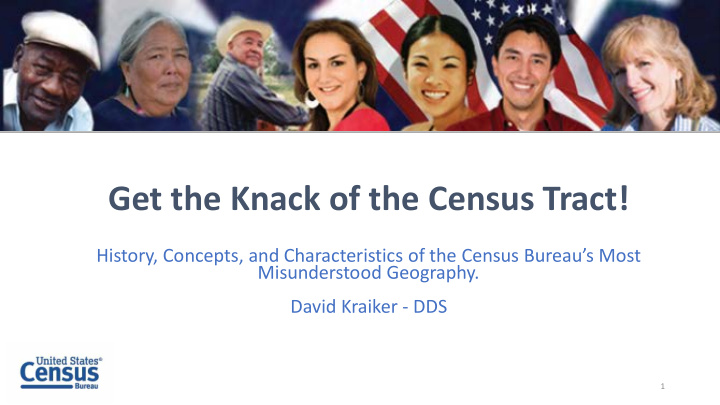



Get the Knack of the Census Tract! History, Concepts, and Characteristics of the Census Bureau’s Most Misunderstood Geography. David Kraiker - DDS 1
References & Further Reading: Butler, J. 1997. “Protestant Success in the New American City, 1870-1920: The Anxious Secrets of Rev. Walter Laidlaw, Ph.D.” in New Directions in American Religious History, Ed. Stout, H. & Hart, D.G. Oxford Univ. Press. Green, H. W. “A Period of Great Growth and Development: 1926-1946” in Proceedings of the National Geographic Areas Conference; Issued Sept 1984, U.S. Census Bureau. Krieger, N. 2006. “A Century of Census Tracts: health & the Body Politic (1906-2006).” Journal of Urban Health: Bulletin of the New York Academy of Medicine. V. 83, No. 3. U.S. Census Bureau, 1966. Census Tract Manual. U.S. Census Bureau, 1947. Census Tract Manual, 3 rd Ed. [Available at: https://www.census.gov/history/www/programs/geography/tracts_and_block_numbering_areas.html] 2
Many Censuses: 1890 - 1910 · National Census · State Censuses · Church Groups Censuses 3
From Sanitary District To Census Tract -Director, Fed. of Churches -Walter Laidlaw -Devised Plan pre-1910 -Census Bureau accepts 4
1910 Census · NYC: 40-acre “districts” · 7 Other cities (over 500K) get “tracts” · Only NYC uses tract data 5
Census Bureau takes up the cause: -mid 1920’s – Chicago & Cleveland purchased data -Howard Whipple Green Retrofits Cleveland 1927 -HWG Appointed chairman of Committee on Census Enumeration Areas -1930 : 18 Cities are tracted 6
Nationwide Tracting · 1940, Tract becomes an official ‘entity’. · 1940: 1st time tract Data is free to cities · Publishes for cities >50,000 · Urban Areas created tract teams. · Block Numbering Areas-What’s that? 7
Population Characteristics of Tracts: · Optimally 4000 people; range between 1200-8000. · The optimal size for ACS data. · Tracts are subdivided if population swells. 8
Geographic Attributes of Tracts : · Originally created with biz districts in mind · Do not cross county boundaries · Do not cross MCD (Town/Twp) lines in NE. · Do not cross CCD boundaries in SE & W 9
Other Attributes of Tracts: · follow the built and natural environment · Wall-to-wall, nationwide regardless of governmental boundaries. · Temporal 10
Tract numbering scheme · Subdivided if population increases, for example: Tract 20.00 becomes 20.01 and 20.02 · Numbers appear differently: 20, 002000 or 0020.00 · Recombining Tracts? · How often? Insert Appropriate Dissemination Controls Here Separated by “-” 11
Current-day Tract delineation. · Once a decade · Splitting and recombining Tracts if necessary. · PSAP - Local Gov’t (County) Participation -Cooperation 12
Anatomy of a Census Tract -Boundary cannot cross County Line -Boundary often extends into water areas -Things we can see on the ground: -street, river, pathway, high- tension line -Surveyed boundaries: -County Boundary, Minor Civil Divisions in the NE
What data is available at a tract level? · ACS 5-year data · Decennial Data · Response-rate data 14
Where can you see your Census tracts? Where can you find data?* TIGERWeb: (http://tigerweb.geo.census.gov/tigerwebmain/tigerweb _main.html) FEDERAL FINANCIAL INSTITUTIONS EXAMINATION COUNCIL https://geomap.ffiec.gov/FFIECGeocMap/GeocodeMap1. aspx Data.census.gov* www.census.gov/roam* 15
Contact Info David Kraiker David.j.Kraiker@census.gov Tel: 202-740-2909 Or, 1-800-ASK-DATA 16
Recommend
More recommend